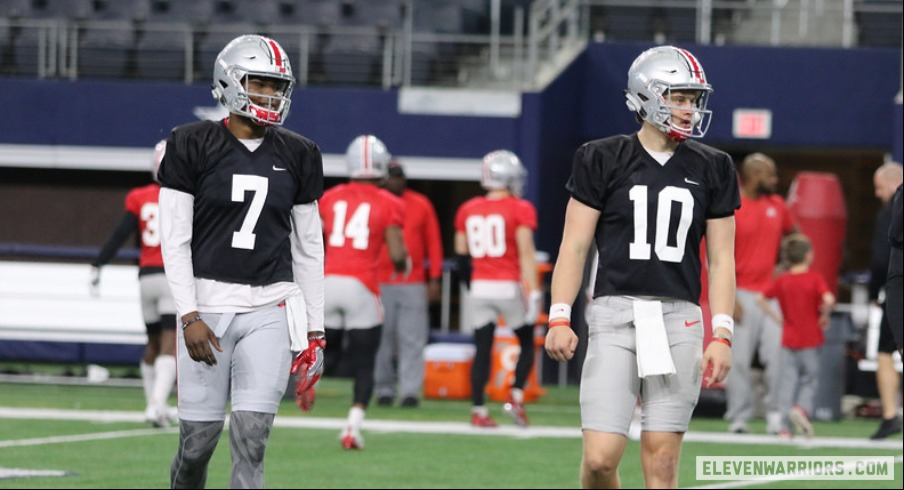With C.J. Stroud off to the NFL after back-to-back seasons as a Heisman Trophy finalist, Ohio State's starting quarterback job is up for grabs.
And what a job it is. The winner of the competition between betting favorite Kyle McCord and the slightly less-seasoned Devin Brown gets to be developed by Ryan Day, operate in an offense built to showcase the signal-caller, throw to elite receivers in Marvin Harrison Jr. and Emeka Egbuka, and become the most popular guy in the state, should he live up to the task.
With the level of quarterback play seen by both veterans and first-year starters since Day joined the staff in 2017, a lot of fans are already assuming McCord or Brown will step right in and light it up. Others are less certain, particularly after neither guy claimed the job in spring ball nor did they draw consistently rave reviews from staffers and media folks alike.
Looking back to the early 2000s to present day at Ohio State, there haven't been very many true quarterback competitions still raging entering fall camp. As far as success rate of the eventual first-year starters, it's been a bit of a mixed bag though, as noted, the most recent results have been electric.
| QB | YEAR | COMP | ATT | PCT | PASS YPG | TD | INT | EFF | RUSH YDS | RUSH TD | TOT TD | TOT YPG |
|---|---|---|---|---|---|---|---|---|---|---|---|---|
| STROUD | 2021 | 317 | 441 | 71.9 | 369.6 | 44 | 6 | 186.6 | -20 | 1 | 45 | 367.9 |
| FIELDS | 2019 | 238 | 354 | 67.2 | 233.8 | 41 | 3 | 181.4 | 484 | 10 | 51 | 268.4 |
| HASKINS | 2018 | 373 | 533 | 70.0 | 345.1 | 50 | 8 | 174.1 | 86 | 4 | 54 | 351.2 |
| BARRETT | 2014 | 203 | 314 | 64.6 | 236.2 | 34 | 10 | 169.8 | 938 | 11 | 45 | 314.3 |
| MILLER | 2011 | 85 | 157 | 54.1 | 96.6 | 13 | 4 | 138.4 | 715 | 7 | 20 | 156.2 |
| PRYOR | 2008 | 100 | 165 | 60.6 | 100.8 | 12 | 4 | 146.5 | 631 | 6 | 18 | 149.4 |
| BOECKMAN | 2007 | 191 | 299 | 63.9 | 183.0 | 25 | 14 | 148.9 | 63 | 1 | 26 | 187.8 |
| SMITH | 2005 | 149 | 237 | 62.9 | 207.5 | 16 | 4 | 162.7 | 611 | 11 | 27 | 263.0 |
| ZWICK | 2004 | 98 | 187 | 52.4 | 172.7 | 6 | 6 | 110.9 | 32 | 1 | 7 | 177.3 |
| KRENZEL | 2002 | 148 | 249 | 56.4 | 150.7 | 12 | 7 | 127.3 | 368 | 3 | 15 | 177.0 |
Flipping the calendar back to 2002, Craig Krenzel was a shoe-in for the starting gig after serving as Steve Bellasari's backup in 2021 and helping the Buckeyes to a 26-20 win over Michigan in his first career start as a result of Bellasari's suspension. Krenzel wasn't spectacular that afternoon, completing 11-of-18 passes for 118 yards with a pick, but he did enough as Jonathan Wells and the OSU executed the heaviest lifting.
Of course Krenzel's poise and penchant for late-game heroics alongside an even better running game and defense in 2002 saw Jim Tressel's Buckeyes win it all. For his part, Krenzel completed 59.2% of his throws for 12 touchdowns against seven picks.
Two seasons later it was Justin Zwick taking over, in front of backups Troy Smith and Todd Boeckman. The 2004 roster was filled with holes but Zwick wasn't all that great either before an injury suffered in a blowout loss to Iowa midway through the season paved the way for Smith to get his feet wet. Zwick would return for the bowl game after Smith was suspended but his season boasted just a 52.4% completion rate with six touchdowns and six picks, going 4-3 as the starter.
Smith's 2004 seasoning paid off in spades in 2005 and despite missing the opener as part of the suspension levied the previous season, the Buckeyes went 9-2 with Smith starting including wins over Michigan and Notre Dame to close out the schedule. Smith completed over 62% of his throws and put up 27 total touchdowns against just four interceptions in a sign of even greater things to come the following year.
Following Smith's 2006 season resulting in a Heisman Trophy and a ticket to the NFL, Tressel again needed to select and break in a new starter. This time it would be Boeckman, ahead of backups Rob Schoenhoft and Antonio Henton. Boeckman got off to a solid start but six of his 14 interceptions on the season came in the last three games, two of which were losses.
Boeckman's 25 touchdowns and near-64% completion rate earned him first team All-B1G status but his play down the stretch even as Ohio State reached the national title game put his status for 2008 in jeopardy.
With the No. 1 blue chip quarterback in Terrelle Pryor now in Columbus, Boeckman started the 2008 season under center but after an embarrassing 35-3 loss to USC, Tressel turned over the keys to the offense to Pryor. The Jeanette, Pennsylvania product did go 8-1 as the starter but offense was mid, particularly the passing game, as the freakish physical talent worked on the finer parts of being a passer.
Fast-forward a few years later and the 2011 season was doomed for more reasons than simply being forced to rely on a new starting quarterback. With Tressel no longer in the fold as a result of lying to NCAA about some dumb stuff, Pryor on the way out for Tressel-related and unrelated issues, and the national media likening the whole thing to Watergate, Ohio State was forced to circle the wagons.
Under center, interim head coach Luke Fickell and an overmatched offensive coordinator worked to choose between Joe Bauserman and true freshman Braxton Miller. The blue chip Miller would evolve into a legendary Buckeye but the raw an uncoached version of him wasn't very good, especially without suspended tailback Boom Herron and wide receiver DeVier Posey. As such, the braintrust went with Bauserman the first three games but Miller started game four and became the lead dog the rest of the way through a painful 6-7 transition season. With no weapons, predictable playcalling and a leaky offensive line complementing Miller's raw ability as a passer, he only attempted at least 20 throws in two games and completed 10 or more only twice as well.
Advancing to 2014, with Urban Meyer entering his third season at the helm and the Buckeyes ready to take a more seasoned Miller and OSU back to the promised land, Braxton's surgically addressed torn labrum fell apart again on a basic throw in fall camp - less than two weeks before the season opener - meaning the backup battle between J.T. Barrett and Cardale Jones was now of critical importance.
Of course Barrett, already the front-runner, would win the job and blow up for 45 total touchdowns before a fractured ankle midway through the Michigan game ended his season. He still racked up a ton of accolades during his 11-1 season including B1G offensive player of the year, B1G quarterback of the year and a 5th-place finish in the Heisman Trophy race.
Four seasons later, it was again time to break in a first-year starter and in hindsight, it was the biggest QB competition in school history. Preceding the 2018 season, Dwayne Haskins served as the backup to Barrett at least in part due to Joe Burrow suffering a broken hand that stalled his ability to compete. Meanwhile, Haskins was forced into action in Ann Arbor with the Buckeyes trailing in the third quarter after an already ailing Barrett further injured his knee.
In response, Haskins completed 6-of-7 passes for 94 yards including a huge third down pass to Austin Mack and a 22-yard scramble to set up the go-ahead touchdown in a 31-20 win. The clutch performance gave Haskins a leg up in the 2018 spring camp battle between he and Burrow and the rest is history.
Meyer named Haskins the starter, Burrow would transfer to LSU, putting up a solid but unspectacular first season before blowing up his second season Baton Rouge. Meanwhile, Haskins went on to break a bunch of OSU single-season records in 2018 including throwing for 50 touchdowns, running for four more and completing 70% of his throws. For his efforts, Haskins was named the league's player and quarterback of the year and he finished third is the Heisman voting behind Kyler Murray and Tua Tagovailoa. Ohio State went 13-1, beat Michigan and won the Rose Bowl on the strength's of Haskins' right arm.
With Haskins turning pro following his incredible 2018 season, Ohio State's quarterback cupboard wasn't in great shape until Justin Fields transferred from Georgia and received a waiver to play right away due to his transition coming as a result of hardship experienced in Athens.
He of course stepped right in and produced an elite season of his own as he guided the Buckeyes to 13-straight wins including a 56-27 victory over Michigan before OSU fell to Clemson in a CFP semifinal that came down to some horrid officiating and a broken route / miscommunication with Fields and Chris Olave that otherwise would've found Ohio State in the winner's circle. Still, Fields cranked out 51 total touchdowns, took home the B1G's offensive player and quarterback of the year honors and finished third in Heisman voting behind Joe Burrow and Jalen Hurts.
With Fields leading the Buckeyes for one more season - the abbreviated 2020 schedule during the pandemic - before being selected in the first round of the NFL Draft, Ryan Day was tasked with selecting and grooming a new starter ahead of the 2021 season.
It proved to be a pretty easy decision and while it wasn't without some bumps in the road, C.J. Stroud proved himself worthy of the position. The redshirt freshman averaged nearly 370 passing yards per game via a blistering 71.9% completion rate, threw 44 touchdown passes against just six interceptions and posted an efficiency rating of 186.6. His exploits earned him B1G offensive player and quarterback of the year awards and a fourth-place finish in the Heisman balloting. Unfortunately, Ohio State lost to Michigan before his historic performance in the Rose Bowl against Utah gave the Buckeyes and 11-2 record.


